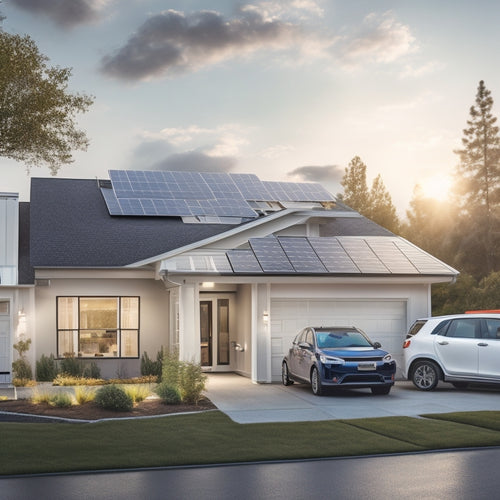
Best Practices for Installing Solar Panels in Office Buildings
Share
When considering solar panels for your office building, you'll want to start by evaluating your building's suitability, including its orientation, shading, and roof size. Assess your current energy consumption patterns and local building codes to determine the right system size. Choose a high-efficiency solar panel that meets local certification standards, and verify your roof can support the weight of the panels. From there, develop a well-planned installation strategy, schedule regular maintenance, and optimize energy output by considering factors like panel direction and tilt angle. By following these best practices, you'll be on your way to utilizing the power of solar energy - and there's more to investigate to maximize your investment.
Key Takeaways
- Conduct a thorough site evaluation to determine solar panel installation feasibility, considering building orientation, shading, and roof size.
- Choose solar panels that prioritize efficiency, durability, and reliability, while ensuring compliance with local and national certification standards.
- Verify roof load capacity to support the weight of solar panels and equipment, considering roof material, age, and condition alongside local building codes.
- Develop a well-planned installation strategy, maintain cleanliness, and schedule regular inspections to optimize energy output and performance.
- Monitor energy production, implement energy storage systems, and conduct shading analysis to maximize energy output and mitigate performance issues.
Assessing Office Building Suitability
Typically, the first step in utilizing solar energy for your office building involves evaluating its suitability for solar panel installation. You'll want to conduct a thorough site evaluation to determine if your building is a good fit for solar energy. This assessment should take into account factors such as the building's orientation, shading, and roof size to determine the potential energy output.
Next, you'll need to assess your office building's energy needs. This involves analyzing your current energy consumption patterns to determine how much energy you need to generate. You can do this by reviewing your past energy bills or conducting an energy audit. This information will help you ascertain the size of the solar panel system required to meet your energy needs.
During the site evaluation, you'll also need to factor in local building codes, zoning regulations, and environmental elements that may impact the installation.
Choosing the Right Solar Panel
Selecting the right solar panel for your office building is a crucial step in the installation process. You want to make sure that you're getting the most out of your investment, and that requires choosing a panel that meets your specific needs.
When evaluating solar panels, consider the following key factors:
-
Panel Efficiency: Look for panels with high efficiency ratings to maximize energy production per unit area.
-
Brand Comparison: Research and compare different brands to find the one that offers the best balance of quality, price, and warranty.
-
Durability and Reliability: Assess the panel's durability and reliability by reviewing its materials, construction, and testing standards.
- Certifications and Compliance: Verify that the panel meets local and national certification standards, such as UL and IEC, to guarantee compliance and safety.
Ensuring Structural Integrity Matters
Your office building's roof is more than just a protective barrier; it's a foundation for your solar panel system. As you prepare for installation, verifying the structural integrity of your roof is essential. You need to take into account the load capacity of your roof to support the weight of the solar panels, mounting hardware, and other equipment.
| Roof Material | Load Capacity |
|---|---|
| Asphalt Shingles | 2-5 psf (pounds per square foot) |
| Metal Roof | 5-10 psf |
| Clay or Concrete Tiles | 10-15 psf |
| Slate Tiles | 15-20 psf |
When evaluating your roof's load capacity, reflect on factors such as the age and condition of the roof, local building codes, and the weight of the solar panel system. You may need to consult with a structural engineer or roofing expert to determine the load capacity of your specific roof. Failure to verify structural integrity can lead to costly repairs, damage to your building, or even injury. By taking the time to assess your roof's load capacity, you can guarantee a safe and successful solar panel installation.
Installation and Maintenance Tips
As you commence the installation process, a well-planned strategy is vital to guarantee a seamless and efficient experience.
You'll want to make sure that your installation techniques are up to par, considering factors such as roof size, orientation, and shading.
When it comes to maintenance, regular checks are important to assure peak performance and longevity of your solar panel system.
Here are some key considerations:
-
Schedule regular inspections: Perform routine checks every 6-12 months to identify and address any potential issues before they become major problems.
-
Keep the panels clean: Regular cleaning is vital to maintain energy output, especially in areas with high levels of pollution or dust.
-
Monitor energy output: Keep track of your energy production to identify any anomalies or drops in performance, which could indicate a maintenance issue.
- Develop a maintenance schedule: Create a schedule that outlines specific tasks and timelines to guarantee your system remains in top condition.
Optimizing Energy Output Performance
Optimizing Energy Output Performance
A well-designed solar panel system is only as effective as its energy output performance. As you install solar panels in your office building, it's essential to guarantee peak energy output. To achieve this, you need to take into account several factors, including solar orientation, energy storage, and system monitoring.
| Optimization Factor | Description |
|---|---|
| Solar Orientation | Confirm panels face the correct direction (south in the northern hemisphere) and are tilted at the best angle to maximize energy output. |
| Energy Storage | Install energy storage systems, such as batteries, to store excess energy generated during the day for use during periods of low sunlight or at night. |
| System Monitoring | Implement a monitoring system to track energy output, identify performance issues, and enable swift maintenance. |
| Shading Analysis | Conduct a shading analysis to identify potential obstructions and optimize panel placement accordingly. |
| Regular Cleaning | Regularly clean the panels to prevent dirt and debris from reducing energy output. |
Frequently Asked Questions
Can Solar Panels Be Installed on Office Building Rooftops With Skylights?
You can install solar panels on office building rooftops with skylights, but you'll need to assess the roof structure's integrity and address installation challenges, such as skylight relocation or custom mounting systems, to guarantee a safe and efficient installation.
Are There Any Tax Incentives for Commercial Solar Panel Installations?
You'll be excited to know that 80% of commercial solar installations are eligible for federal incentives! You can claim a 30% tax credit for your commercial solar panel installation, and don't forget to investigate state rebates, which can total up to 50% of the project cost.
Can Solar Panels Be Integrated With Existing Office Building Electrical Systems?
You can seamlessly integrate solar panels with your existing office building's electrical system, ensuring grid integration and optimizing energy efficiency by incorporating inverters and monitoring systems that sync with your building's infrastructure.
Do Solar Panels Void Office Building Roof Warranties?
When you install solar panels, you'll want to review your office building's roof warranty to guarantee it remains valid; following installation best practices and considering roof warranty considerations can help you avoid voiding the warranty.
Can Office Buildings Sell Excess Energy Back to the Grid?
As you capture the sun's golden rays, you'll likely generate more energy than you need; with net metering benefits and energy buyback programs, you can sell excess energy back to the grid, offsetting your bills and earning revenue.
Conclusion
As you flip the switch on your new solar panel installation, remember that the real work begins. The road to energy independence is paved with regular maintenance, peak performance, and a keen eye on structural integrity. Don't let your investment gather dust - stay vigilant, and your office building will shine like a lighthouse of sustainability, illuminating the path for others to follow. After all, a well-installed solar panel system is not just a feature, but a promise of a brighter future.
Related Posts
-

What Electric Vehicle Owners Need for Home Energy
As an electric vehicle owner, you need to optimize your home energy system to guarantee efficient, sustainable, and c...
-

10 Best Solar Panel Options for Motorhomes Online
When choosing the best solar panel for your motorhome, consider factors like efficiency, durability, and design. You'...
-

Eco-Friendly Car Battery Solutions Available Online
You can now shop online for eco-friendly car battery solutions that not only reduce your carbon footprint but also of...


